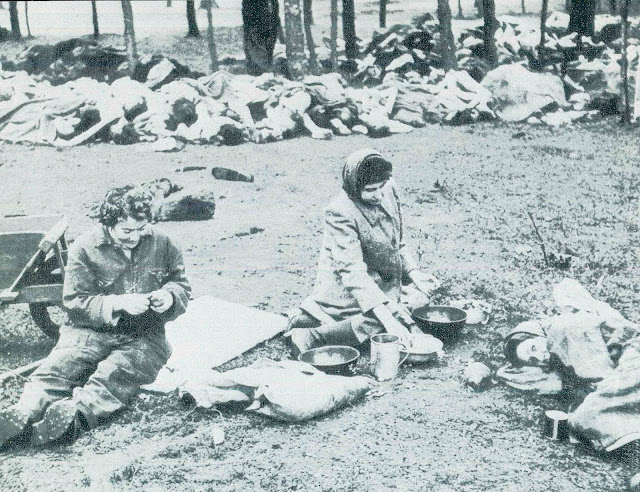Piles of dead Jewish prisoners were deposited near the Bergen-Belsen concentration camp. A former female prisoner at the Bergen-Belsen concentration camp prepares a meal by peeling potatoes in the open air with its numerous groups of rotting corpses on April 21, 1945.
The Bergen-Belsen concentration camp was liberated by British troops on April 15, 1945. Approximately 50,000 people died at Bergen-Belsen during the camp's existence. When the British liberators entered the camp, they witnessed evidence of the atrocities committed by the Nazi Germans and the horrific conditions faced by the prisoners. The British soldiers found about 60,000 prisoners inside the camp. Most of them were half-starved and seriously ill. In addition, about 13,000 corpses were lying buried around the camp.
Faced with a humanitarian crisis, the British military organized emergency medical aid. By April 16, about 27 water wagons and enough food had been provided. Rationing from the military had a negative effect on the weakened prisoners. Their malnourished bodies could not cope as food became much more plentiful than before.
The diet was steadily improved while the health of the prisoners was monitored. based on the experience of the Bengal famine in India in 1943, a special stomach diet was implemented for prisoners on the verge of starvation. limited amounts of milk, sugar and water were given to the prisoners by the British medical volunteers who arrived on April 29. the prisoners were then given a small amount of milk, sugar and water. Despite these efforts, some 14,000 more people died after the camp was liberated.
The German military authorities established the Bergen-Belsen camp in 1940. until 1943, Bergen-Belsen was only a prisoner of war (POW) camp. in April 1943, the SS administrative headquarters converted the camp into a concentration camp. It consisted of POW camps, residential camps, and prisoner camps. It housed Jews, prisoners of war, political prisoners, Roma (Gypsies), working people, criminals, Jehovah's Witnesses, and homosexuals. When Allied and Soviet troops invaded German soil in late 1944 and early 1945, Bergen-Belsen became a camp for thousands of Jewish prisoners evacuated from nearby camps. In one fell swoop, thousands of new prisoners arrived, many of them survivors of forced evacuations on foot, straining the camp's meager resources. in January 1945, a large women's camp was also established to house the large number of displaced women. The number increased to about 7,300 at the end of July 1944, about 15,000 at the beginning of December 1944, about 22,000 in February 1945, and jumped to more than 60,000 on April 15, 1945.
Beginning in late 1944, overall food rations continued to decline; by early 1945, prisoners had been without food and water for days. Sanitary conditions were inadequate, with few toilets and water taps for the tens of thousands of prisoners. Overcrowding, poor sanitation, and lack of adequate food, water, and shelter led to outbreaks of typhus, tuberculosis, typhoid, dysentery, and other diseases, and the death toll continued to rise. tens of thousands of prisoners died in the first few months of 1945.

